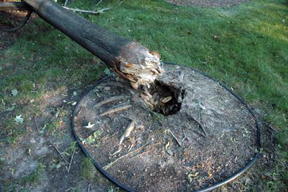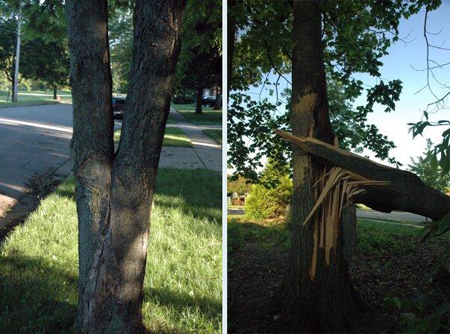Riding the storm out: Observe tree failures and prevent them for the future
Editor’s note: This article is from the archives of the MSU Crop Advisory Team Alerts. Check the label of any pesticide referenced to ensure your use is included.
Late spring and early summer are usually severe weather months in Michigan and this year is no exception. Several rounds of storms have made their way through the state in the past few weeks with heavy rains, high winds and even a few tornados. I inspected some of the damage from a storm that moved through East Lansing and Haslett a couple of weeks ago. Severe weather outbreaks provide some opportunities to observe tree failures and gain insights into how they can be prevented. Or, as Yogi Berra put it, “You can observe a lot just by watching.”
A common sight after a storm in this area is wind-throw in shallow-rooted species, such as spruce and pines, especially if high winds are preceded by heavy rainfall. Another factor is limited root development due to edging or root barriers. I don’t have any specific data, but I have seen several cases where wind-throw occurred on trees in which mulch was underlain with landscape fabric (Photos 1, 2). Perhaps coincidence, but another strike against the stuff in my mind.
This maple provided one of the best (or worst) examples I have seen of planting too deep (Photo 3). The tree snapped off about six-inches below ground line. Note that there are plenty of pretty stout roots that look like structural roots near the surface, but none of these originated near the current ground line!
By far the most common problem in this storm, and most of our typical thunderstorms, was large limb breakage associated with narrow crotches (Photo 4, 5). This occurred in a variety of species; oaks, maples, elms and pines. Narrow branch angles often form from multiple leaders, which results in weak branch attachment as included bark forms and gradually reduces the proportion of wood attaching the branch to the tree. The encouraging thing, or maybe discouraging depending on your point of view, is that this is one of the most easily preventable tree defects. Pruning double leaders or multiple leaders back to single leaders and eliminating other poor branch angles when small can easily prevent this type of breakage. For most of our garden-variety thunderstorms, eliminating narrow crotches would probably eliminate 50 percent or more of our tree-related storm damage.
Once storm damage has occurred, there are several sources of information that homeowners may find useful.
Can these trees be saved?
I get this question a lot, and this illustrated guide from the National Arbor Day Foundation is a useful tool to help homeowners assess the likelihood of a tree recovering after storm damage: http://bit.ly/stormrecovery
Find a certified arborist
This handy website from the International Society of Arboriculture enables homeowners to search for nearby certified arborists based on their zip code: http://bit.ly/treeservices
Like most services, prices for tree removal or trimming can vary widely. Seek out multiple bids, if possible. MSU Extension Senior District Educator, Tom Dudek, reports he recently obtained three estimates for removal and stump-grinding of a storm-damaged spruce; estimates varied by nearly three-fold. He took the low bid and was satisfied with the work. Homeowners should always check for certification and insurance when hiring a tree service. Resist high-pressure sales tactics and be wary of “door knockers,” individuals that swoop in right after a storm offering removal services.



 Print
Print Email
Email







